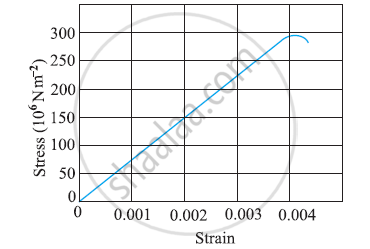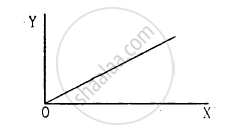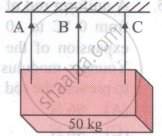Advertisements
Advertisements
प्रश्न
A copper wire of cross-sectional area 0.01 cm2 is under a tension of 20N. Find the decrease in the cross-sectional area. Young modulus of copper = 1.1 × 1011 N m−2 and Poisson ratio = 0.32.
`["Hint" : (Delta"A")/"A"=2(Delta"r")/"r"]`
उत्तर
Given:
Cross-sectional area of copper wire A = 0.01 cm2 = 10−6 m2
Applied tension T = 20 N
Young modulus of copper Y = 1.1 × 1011 N/m2
Poisson ratio σ = 0.32
We know that: \[Y = \frac{FL}{A ∆ L}\]
\[\Rightarrow \frac{∆ L}{L} = \frac{F}{AY}\]
\[ = \frac{20}{{10}^{- 6} \times 1 . 1 \times {10}^{11}} = 18 . 18 \times {10}^{- 5} \]
\[\text{ Poisson's ratio }, \sigma = \frac{\frac{∆ d}{d}}{\frac{∆ L}{L}} = 0 . 32\]
\[\text{ Where d is the transverse length }\]
\[\text{ So }, \frac{∆ d}{d} = \left( 0 . 32 \right) \times \frac{∆ L}{L}\]
\[ = 0 . 32 \times \left( 18 . 18 \right) \times {10}^{- 5} = 5 . 81 \times {10}^{- 5} \]
\[\text{ Again }, \frac{∆ A}{A} = \frac{2 ∆ r}{r} = \frac{2 ∆ d}{d}\]
\[ \Rightarrow ∆ A = \frac{2 ∆ d}{d}A\]
\[ \Rightarrow ∆ A = 2 \times \left( 5 . 8 \times {10}^{- 5} \right) \times \left( 0 . 01 \right)\]
\[ = 1 . 164 \times {10}^{- 6} {\text{ cm }}^2\]
Hence, the required decrease in the cross -sectional area is \[1 . 164 \times {10}^{- 6} {\text{ cm } }^2\]
APPEARS IN
संबंधित प्रश्न
The figure shows the strain-stress curve for a given material. What are (a) Young’s modulus and (b) approximate yield strength for this material?

A 14.5 kg mass, fastened to the end of a steel wire of unstretched length 1.0 m, is whirled in a vertical circle with an angular velocity of 2 rev/s at the bottom of the circle. The cross-sectional area of the wire is 0.065 cm2. Calculate the elongation of the wire when the mass is at the lowest point of its path.
The length of a metal wire is l1 when the tension in it T1 and is l2 when the tension is T2. The natural length of the wire is
A student plots a graph from his reading on the determination of Young modulus of a metal wire but forgets to put the labels. the quantities on X and Y-axes may be respectively

(a) weight hung and length increased
(b) stress applied and length increased
(c) stress applied and strain developed
(d) length increased and the weight hung.
A uniform rectangular block of mass of 50 kg is hung horizontally with the help of three wires A, B and C each of length and area of 2m and 10mm2 respectively as shown in the figure. The central wire is passing through the centre of gravity and is made of material of Young's modulus 7.5 x 1010 Nm−2 and the other two wires A and C symmetrically placed on either side of the wire B are of Young's modulus 1011 Nm−2 The tension in the wires A and B will be in the ratio of:

Young's modulus of a perfectly rigid body is ______.
The temperature of a wire is doubled. The Young’s modulus of elasticity ______.
A rigid bar of mass M is supported symmetrically by three wires each of length l. Those at each end are of copper and the middle one is of iron. The ratio of their diameters, if each is to have the same tension, is equal to ______.
Identical springs of steel and copper are equally stretched. On which, more work will have to be done?
What is the Young’s modulus for a perfect rigid body ?
A steel wire of mass µ per unit length with a circular cross section has a radius of 0.1 cm. The wire is of length 10 m when measured lying horizontal, and hangs from a hook on the wall. A mass of 25 kg is hung from the free end of the wire. Assuming the wire to be uniform and lateral strains << longitudinal strains, find the extension in the length of the wire. The density of steel is 7860 kg m–3 (Young’s modules Y = 2 × 1011 Nm–2).
If the yield strength of steel is 2.5 × 108 Nm–2, what is the maximum weight that can be hung at the lower end of the wire?
A steel rod of length 2l, cross sectional area A and mass M is set rotating in a horizontal plane about an axis passing through the centre. If Y is the Young’s modulus for steel, find the extension in the length of the rod. (Assume the rod is uniform.)
In nature, the failure of structural members usually result from large torque because of twisting or bending rather than due to tensile or compressive strains. This process of structural breakdown is called buckling and in cases of tall cylindrical structures like trees, the torque is caused by its own weight bending the structure. Thus the vertical through the centre of gravity does not fall within the base. The elastic torque caused because of this bending about the central axis of the tree is given by `(Ypir^4)/(4R) . Y` is the Young’s modulus, r is the radius of the trunk and R is the radius of curvature of the bent surface along the height of the tree containing the centre of gravity (the neutral surface). Estimate the critical height of a tree for a given radius of the trunk.
If Y, K and η are the values of Young's modulus, bulk modulus and modulus of rigidity of any material respectively. Choose the correct relation for these parameters.
The force required to stretch a wire of cross section 1 cm2 to double its length will be ______.
(Given Young's modulus of the wire = 2 × 1011 N/m2)
